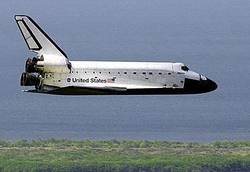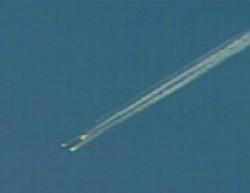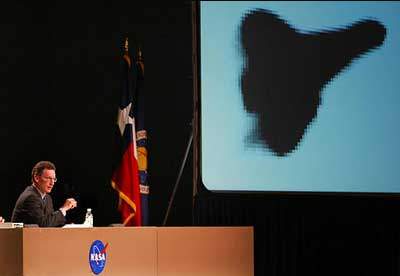NASA Says "No."
 Two years before Saturday's Columbia
disaster, NASA safety experts who were worried about damage to
delicate heat tiles on the space shuttle Atlantis decided
it was "prudent" to adjust its return path to lessen danger during
the fiery descent.
Two years before Saturday's Columbia
disaster, NASA safety experts who were worried about damage to
delicate heat tiles on the space shuttle Atlantis decided
it was "prudent" to adjust its return path to lessen danger during
the fiery descent.
Internal NASA documents show that, during an Atlantis
mission in May 2000 (STS-101), the experts were concerned about
damage to tiles on the wing.
Approximately 80 seconds after lift-off, January 16, the
underside of Columbia's left wing was smacked by a piece
of insulating foam which fell from the orbitor's huge orange fuel
tank. Early investigations into last weekend's breakup of the
Columbia as it re-entered the atmosphere have centered on
the space plane's left main wheel well, located in the area hit by
the chunk of foam.
The concern over the Atlantis mission in 2000 was
similar, involving a slightly smaller area than the damage
suspected to the shuttle that disintegrated over Texas last
weekend, documents show.
If It Worked Then...
 In May, 2000, Atlantis adjusted its
return flight because experts noticed a 6-inch ice chunk from its
external fuel tank shattered about 8 feet from one of the
"elevons," along the back of the wing.
In May, 2000, Atlantis adjusted its
return flight because experts noticed a 6-inch ice chunk from its
external fuel tank shattered about 8 feet from one of the
"elevons," along the back of the wing.
"It was prudent to take some precautions," according to NASA
documents. The maneuver to pivot Atlantis to protect its
right wing "increased the temperature margin and therefore reduced
the potential for structural damage.""It was prudent to take some
precautions," according to NASA documents. The maneuver to pivot
Atlantis to protect its right wing "increased the
temperature margin and therefore reduced the potential for
structural damage.""It was prudent to take some precautions," the
NASA documents reportedly said. The maneuver to pivot
Atlantis to protect its right wing "increased the
temperature margin and therefore reduced the potential for
structural damage."
Ever since the Columbia disaster, NASA has maintained
there was nothing that could have been done for the seven
astronauts aboard Columbia if there was indeed serious
damage to those tiles. But the Atlantis mission, in which
the crew was instructed to make a protective re-entry, suggests
there were at least options for an ailing shuttle to return
safely.
 NASA
spokesman Michael Braukus said Friday the space agency did not
consider ordering Columbia to make the same maneuver, and
believes now that it would have interfered with efforts to warm
Columbia's landing gear tires for a safe landing.
NASA
spokesman Michael Braukus said Friday the space agency did not
consider ordering Columbia to make the same maneuver, and
believes now that it would have interfered with efforts to warm
Columbia's landing gear tires for a safe landing.
The tires were unusually cold because Columbia orbited
the Earth for 16 days with its landing gear pointed at deep space,
he said.
The damage in May 2000 to Atlantis' right wing "was not
considered a safety of flight issue," NASA's documents show.
Inspectors later found a gouge in thermal tiles there, measuring
about 5.25 inches by 1.5 inches by one-half inch.
NASA officials have said they also concluded that possible
damage to Columbia's insulating tiles didn't threaten the
shuttle's safety. They based their conclusions on scientific models
showing possible damage over an area about 7 inches by 32 inches
larger than the damage to Atlantis years earlier.
Outside experts said it was impossible to know yet whether
flight adjustments by Columbia could have prevented its
destruction.
"You can yaw the vehicle to the side, you can roll the vehicle a
little bit," said Steven P. Schneider, an associate professor at
Purdue University's Aerospace Sciences Laboratory. He said some
shuttle surfaces, such as near the fuselage or the back edges of
the wings, could be better shielded during such maneuvers than
others. "You can't change the trajectory too much."
A 1990 study for NASA by outside researchers said threats to the
shuttle from damaged thermal tiles which protect against
temperatures that can reach 3,000 degrees could be lessened by
rerouting important internal systems or changing the shuttle's
re-entry profile. Using that technique, researchers wrote, "it may
be possible to reduce the temperature of some weak, vulnerable
areas."
What The Air Force Saw...What The Computer Didn't
The Air Force told CBS News imagery from Kirtland Air Force Base
in New Mexico was turned over to NASA for analysis. Kirtland
operates powerful telescopes in Hawaii and the continental United
States, including the Starfire Optical Range in New Mexico that
would have been well-positioned to follow Columbia's fiery plunge
through the atmosphere.
NASA confirmed Friday it received photos of Columbia from a
powerful Air Force ground camera, but Dittemore who showed one of
the images to reporters said it wasn't clear whether it showed
structural damage to Columbia's left wing.

"All by itself, I don't think it's very revealing," he said.
Hopes have faded that NASA might get more information from data
from the final 32 seconds recorded between the time Johnson Space
Center's computers stopped reading the data to the point all
sensors went dead. The data was too garbled to be interpreted and
was largely useless, said James Gavura, director of NASA's Tracking
and Data Relay Satellite System.
"There was 31 seconds (of silence) and then 1 more second of
data," Gavura said.
That second could contain information on the position of the
orbiter just before it began to tumble and break up, he said.
Although that second hasn't been verified as shuttle data,
Gavura said it appears to have the proper signature.
 ANN's Daily Aero-Linx (04.15.24)
ANN's Daily Aero-Linx (04.15.24) Classic Aero-TV: 'No Other Options' -- The Israeli Air Force's Danny Shapira
Classic Aero-TV: 'No Other Options' -- The Israeli Air Force's Danny Shapira Aero-News: Quote of the Day (04.15.24)
Aero-News: Quote of the Day (04.15.24) Airborne 04.16.24: RV Update, Affordable Flying Expo, Diamond Lil
Airborne 04.16.24: RV Update, Affordable Flying Expo, Diamond Lil ANN's Daily Aero-Term (04.16.24): Chart Supplement US
ANN's Daily Aero-Term (04.16.24): Chart Supplement US






